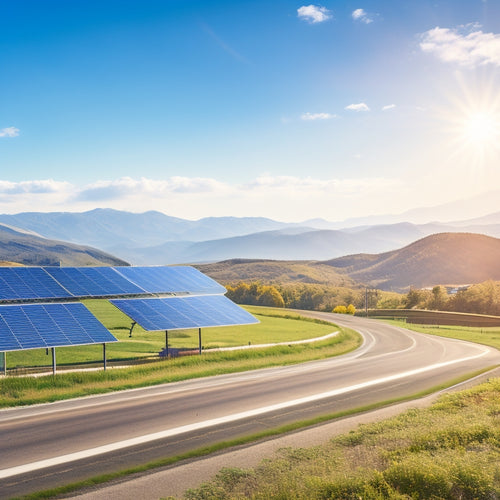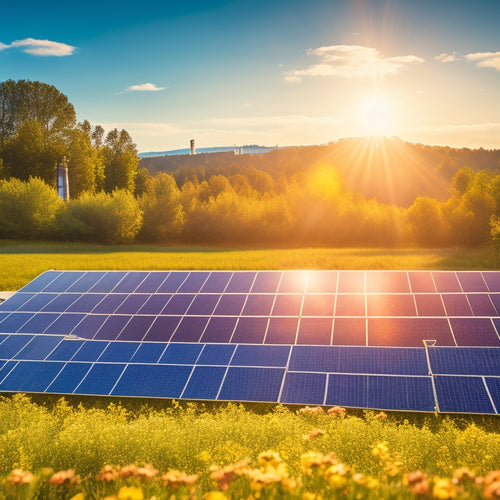
Inverter Troubleshooting: 3 Essential Tips
Share
When troubleshooting your inverter, start by identifying error codes and understanding their meanings to guarantee accurate diagnosis. Next, inspect inverter connections for damage, wear, or security issues, and confirm the power rating meets total device wattage and surge capacity. Finally, perform basic maintenance tasks like cleaning vents and fans, monitoring battery health, and scheduling routine checks to prevent future issues. By following these essential tips, you'll be well on your way to resolving inverter problems and optimizing performance - and there's more to investigate to get your system running smoothly.
Overview
- Identify inverter error codes by consulting the manual or online resources to accurately troubleshoot issues and enhance error code accuracy.
- Inspect inverter cables for damage or wear, and verify cable integrity to ensure secure connections and prevent errors.
- Perform regular maintenance tasks, such as inspecting vents and fans, to maintain cleanliness and airflow, and prevent future issues.
- Ensure inverter compatibility with solar panels, battery chemistry, and appliances to prevent errors and damage.
- Match displayed error codes with descriptions to effectively troubleshoot issues and resolve problems quickly.
Identify Inverter Error Codes
Troubleshooting an inverter issue often starts with deciphering cryptic error codes. You'll need to understand error code meanings to identify the root cause of the problem. Check your inverter's manual or online resources to find the error code list specific to your model.
When selecting an inverter, it's important to evaluate factors like energy requirements and sizing, which can affect the accuracy of error codes. Additionally, ensuring compatibility with solar panels and systems can help prevent errors from occurring in the first place.
Match the code on your inverter's display to the corresponding description in the list. This will give you a clear direction for your troubleshooting procedures. Don't skip this step, as misinterpreting the error code can lead to wasted time and effort.
Check Inverter Connection Issues
Once you've identified the error code, it's important to investigate potential connection issues.
Start by inspecting the inverter's cables for signs of damage or wear. Check the cable integrity by verifying that all connections are secure and not loose. Make certain the cables aren't pinched, crushed, or exposed to environmental elements.
It's crucial to confirm the inverter's power rating meets total device wattage, including surge capacity, to prevent overload issues. Additionally, review the inverter's waveform type to verify it's compatible with your appliances, as using the wrong type can lead to malfunctions.
Perform grounding checks to validate the inverter is properly grounded. Verify that the ground wire is securely attached to the inverter and the grounding point.
If you find any issues, repair or replace the cables as needed. Remember, faulty connections can cause inverter malfunctions, so it's important to address these issues promptly.
Perform Basic Inverter Maintenance
With your inverter's connections checked and secured, it's essential to perform basic maintenance tasks to prevent future issues and guarantee peak performance.
You should regularly inspect your inverter's vents and fans to confirm they're clean and free from dust. This helps maintain ideal operating temperatures, which is critical for your inverter's lifespan.
Additionally, selecting an inverter that's compatible with your battery chemistry inverter compatibility is necessary to prevent damage and system failure.
Monitor your battery health by checking its state of charge, voltage, and temperature. This helps identify potential issues before they become major problems.
Frequently Asked Questions
How Do I Reset My Inverter After a Power Outage?
You'll need to check your inverter's manual for specific reset instructions, but generally, you'll want to make certain battery maintenance is up to par, then restart the inverter, verifying it's compatible with your system, before resuming normal operation.
Can I Use a Surge Protector With My Inverter?
Like a knight shielding its kingdom, a surge protector can safeguard your inverter from power spikes, but you'll need to guarantee compatibility to avoid frying your system; check the inverter's manual for safety concerns and compatible surge protector models.
How Often Should I Update My Inverter's Firmware?
You should update your inverter's firmware regularly, ideally every 6-12 months, to guarantee you reap firmware benefits like improved efficiency, enhanced features, and bug fixes, granting you more freedom to focus on what matters.
Will an Inverter Work With a Generator as a Power Source?
You'll be glad to know that your inverter can work with a generator as a power source, but you'll need to ascertain generator compatibility and optimize inverter efficiency to avoid energy waste and achieve reliable off-grid power.
Can I Install an Inverter in a Humid or High-Temperature Environment?
You're pushing the limits, just like a generator's power output! Installing an inverter in humid or high-temperature environments requires careful consideration of humidity effects and temperature tolerance to guarantee peak performance and longevity.
Ready to Buy
You've maneuvered the troubleshooting terrain, and your inverter's humming back to life. Like a puzzle, you've fitted the pieces together, decoding error codes, checking connections, and performing maintenance. Now, your system's singing in harmony, efficiently converting DC to AC power. With these essential tips, you're the maestro, conducting an orchestra of reliability and efficiency.
Related Posts
-

Is This the Future of Alternative Energy Systems
Yes, alternative energy systems are shaping the future of energy. Innovations in solar and wind technologies are driv...
-

Is Switching to Green Energy Solutions Easy
Switching to green energy solutions isn't just easy; it's also beneficial. You can greatly cut utility costs and enjo...
-

Advantages of Solar Generating Systems Over Traditional Energy
Solar generating systems provide several key advantages over traditional energy sources. You'll experience lower long...


